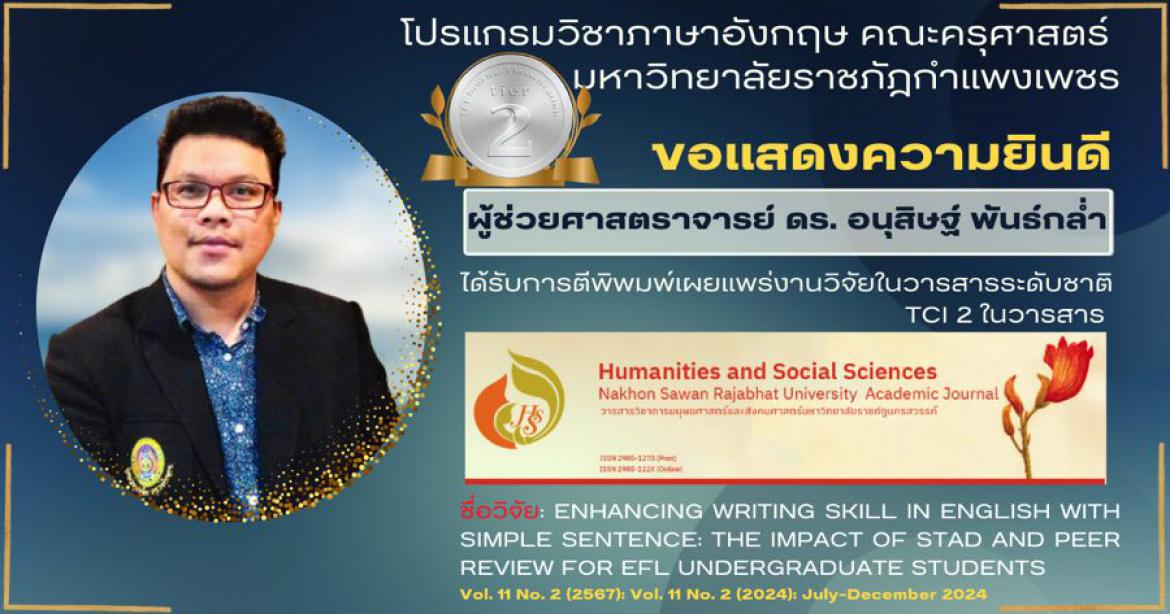ลำดับ 91. ประชุมจัดทำเล่มหลักสูตร
เผยแพร่เมื่อ 23-05-2023 ผู้ชม 543,599 Share
วันที่ 23 พฤษภาคม 2566 เวลา 09.00-12.00 โปรแกรมวิชาภาษาอังกฤษ นำโดย ผศ.อนุสิษฐ์ พันธ์กล่ำ ผศ.ดร.ถิรวิท ไพรมหานิยม และ อาจารย์ธารณา สุวรรณเจริญ เข้าร่วมประชุมในการชี้แจงการจัดทำรูปเล่มหลักสูตร (ฉบับปรับปรุง) 2567 ณ ห้องประชุมคณะครุศาสตร์ เพื่อให้หลักสูตรได้แนวทางในการจัดทำรูปเล่มให้เป็นไปในแนวทางเดียวกันทั้งคณะ
ลำดับ 92. คำสั่ง/ประกาศ
เผยแพร่เมื่อ 09-05-2023 ผู้ชม 986,317 Share
ลำดับ 93. ปฐมนิเทศนักศึกษาฝึกประสบการณ์วิชาชีพครู 1/66
เผยแพร่เมื่อ 02-05-2023 ผู้ชม 678,309 Share
ประชาสัมพันธ์แจ้งนักศึกษาชั้นปีที่4 เข้าร่วมกิจกรรมปฐมนิเทศนักศึกษาฝึกประสบการณ์วิชาชีพครู ในระหว่างวันที่ 7 - 8 พ.ค. 2566 ณ หอประชุมรัตนอาภา และเรียนเชิญเข้าร่วมต้อนรับผู้บริหารโรงเรียน ครูพี่เลี้ยงจากโรงเรียนเครือข่ายฝึกประสบการณ์วิชาชีพครู และร่วมส่งนักศึกษาให้กับทางโรงเรียนได้บ่มเพาะความเป็นครูให้กับนักศึกษา ในวันที่ 8 พ.ค. 2566 ณ หอประชุมรัตนอาภา
ลำดับ 94. วิพากษ์หลักสูตรภาษาอังกฤษ ครั้งที่ 3 (ระดับคณะ)
เผยแพร่เมื่อ 28-04-2023 ผู้ชม 53,269,528 Share
วันที่ 28 เมษายน 2566 โปรแกรมวิชาภาษาอังกฤษ คณะครุศาสตร์ มหาวิทยาลัยราชภัฏกำแพงเพชร ดำเนินการวิพากษ์หลักสูตรภาษาอังกฤษ ครั้งที่ 3 ระดับคณะ โดยมีผู้ทรงคุณวุฒิ ประกอบด้วย 1) รศ.ดร.บัณฑิต ฉัตรวิโรจน์ คณบดี คณะครุศาสตร์ ประธานกรรมผู้ทรงคุณวุฒิ (ภายใน) 2) ดร.ศักดิ์ชัย เพชรแกมทอง ผู้อำนวยการสำนักงานเขตพื้นที่มัธยมศึกษากำเแพงเพชร ผู้ทรงคุณวุฒิภายนอก 3) ท่านวินัย เมฆหมอก ผู้อำนวยการสำนักงานเขตพื้นที่ประถมศึกษา จ. ตาก เขต 1 ผู้ทรงคุณวุฒิภายนอก และ 3) ผู้ช่วยศาสตราจารย์ ดร.ประจบ ขวัญมั่น อาจารย์ประจำคณะครุศาสตร์ ผู้ทรงคุณวุฒิภายใน โดยมีวัตถุประสงค์เพื่อปรับปรุงแก้ไขหลักสูตรฯ ให้มีความถูกต้องสมบูรณ์ เพื่อนำเสนอต่อสภามหาวิทยาลัยในลำดับต่อไป
ลำดับ 95. VDO กิจกรรมวิพากษ์หลักสูตรภาษาอังกฤษ 2567 ครั้งที่ 2
เผยแพร่เมื่อ 26-04-2023 ผู้ชม 9,866,102 Share
ลำดับ 96. กิจกรรมวิพากษ์หลักสูตรภาษาอังกฤษ 67 ครั้งที่ 2
เผยแพร่เมื่อ 21-04-2023 ผู้ชม 255,885 Share
วันที่ 21 เมษายน 2566 โปรแกรมวิชาภาษาอังกฤษ คณะครุศาสตร์ มหาวิทยาลัยราชภัฏกำแพงเพชร ได้จัดกิจกรรมเสวนาแลกเปลี่ยนและวิพากษ์หลักสูตรสาขาวิชาภาษาอังกฤษ (ปรับปรุง 2567) ครั้งที่ 2 โดยมีกรรมการผู้ทรงคุณวุฒิ ตังต่อไปนี้ 1) ผู้ช่วยศาสตราจารย์ชลชลิตา กมุทธภิไชย ประธานกรรมการ โปรแกรมวิชาภาษาอังกฤษ คณะครุศาสตร์ มรภ.กำแพงเพชร 2) ผู้ช่วยศาสตราจารย์ปทุมพร บุญชุม กรรมการผู้ทรงคุณวุฒิภายนอก มรภ.พิบูลส่งคราม 3) นายพิธาร คำสีทา ผู้ใช้บัณฑิต ครูวิทยฐานะชำนาญการ โรงเรียนคลองขลุงราฎร์รังสรรค์ 4) นายสุพพัต ทองกรณ ศิษย์เก่า ครูผู้ช่วย โรงเรียนเทวัญอำนวยวิทย์ 5) นางสาวนิภัทร์สิริ พวงไธสง ศิษย์ปัจจุบันชั้นปีสุดท้าย โดยมีวัตถุประสงค์เพื่อนำข้อเสนอแนะในประเด็นต่างๆ จากกรรมการผู้ทรงคุณวุฒิทุกท่านไปปรับปรุงเนื้อหาสาระของหลักสูตรสาขาวิชาภาษาอังกฤษ หลักสูตร 2567 ให้สอคล้องกับความต้องการของผู้มีส่วนได้ส่วนเสียต่อไป
ลำดับ 97. กิจกรรมวิพากษ์หลักสูตร มรภ.สุรินทร์
เผยแพร่เมื่อ 20-04-2023 ผู้ชม 257,223 Share
20 เมษายน 2566 ผู้ช่วยศาสตราจารย์ ดร.ถิรวิท ไพรมหานิยม ได้รับเกียรติจาก ท่าน ดร.วิโรจน์ ทองปลิว รองคณบดีฝ่ายศิลปวัฒนธรรมและกิจการพิเศษ และคณาจารย์ สาขาวิชาภาษาอังกฤษ คณะมนุษยศาสตร์และสังคมศาสตร์ มรภ.สุรินทร์ ในการร่วมเสวนาแลกเปลี่ยนและวิพากษ์หลักสูตร หลักสูตรครุศาสตรบัณฑิต สาชาวิชาภาษาอังกฤษ (4ปี) หลักสูตรปรับปรุง พ.ศ.2567 ในรูปแบบออนไลน์ผ่านช่องทาง MS Team
ลำดับ 98. รูปหมู่นักศึกษาแต่ละรุ่น
เผยแพร่เมื่อ 19-04-2023 ผู้ชม 38,117 Share
| ภาพแห่งความทรงจำ นักศึกษาโปรแกมวิชาภาษาอังกฤษ คณะครุศาสตร์ มหาวิทยาลัยราชภัฏกำแพงเพชร |





ลำดับ 99. Contact us now
เผยแพร่เมื่อ 09-04-2023 ผู้ชม 23,698,207 Share
ลำดับ 100. กิจกรรม Goodbye Senior 2023
เผยแพร่เมื่อ 02-04-2023 ผู้ชม 2,370,481 Share
วันที่ 1 เมษายน 2566 โปรแกรมวิชาภาษาอังกฤษ คณะครุศาสตร์ มหาวิทยาลัยราชภัฏกำแพงเพชร ได้จัดกิจกรรมปัจฉิมนิเทศนักศึกษาก่อนจบการศึกษาของนักศึกษาชั้นปีสุดท้าย จำนวน 66 คน โดยมีวัตถุประสงค์ 1) เพื่อให้นักศึกษามีความมั่นใจและบุคลิกภาพที่ดีต่อการเข้าสู่วิชาชีพ 2) เพื่อให้นักศึกษาที่จะสำเร็จการศึกษามีขวัญและกำลังใจต่อการที่จะเริ่มต้นชีวิตในการทำงาน 3) เพื่อให้นักศึกษาตระหนักถึงความสำคัญของการเตรียมความพร้อมก่อนการเข้าสูวิชาชีพการทำงานต่อไปในอนาคต 4) เพื่ออนุรักษ์วัฒนธรรมอันดีงามของในการล่าวลาและอวยพรของรุ่นน้องที่มีต่อรู่นพี่ และ 5) เพื่อแสดงความยินดีต่อนักศึกษาหลักสูตร 5 ปีและหลักสูตร 4 ปี ที่จะสำเร็จการศึกษา
ในโอกาศนี้ในนามของคณาจารย์โปรแกรมวิชาภาษาอังกฤษ ขออำนวยอวยพรให้นักศึกษาทุกท่านจงเจริญด้วยอายุ วรรณะ สุขะ พละ และเจริญก้าวหน้าในหน้าที่การงาน คิดหวังสิ่งใดอันประกอบด้วยชอบธรรมจงสมความปรารถนาทุกประการ เป็นครูที่ดีและเป็นกำลังสำคัญของชาติสืบไป


















.jpg)









